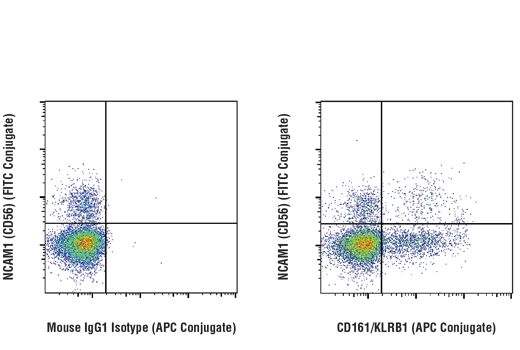FC-L
H
Endogenous
Mouse IgG1 kappa
#Q12918
3820
Product Information
Product Usage Information
| Application | Dilution |
|---|---|
| Flow Cytometry (Live) | 1:20 |
Storage
Specificity / Sensitivity
Species Reactivity:
Human
Source / Purification
This monoclonal antibody was purified from tissue culture supernatant via affinity chromatography. The purified antibody was conjugated under optimal conditions, with unreacted dye removed from the preparation.
Product Description
Background
CD161/KLRB1 (Killer cell lectin-like receptor subfamily B member 1, also known as CLEC5B and NKR-P1A) is a type II transmembrane protein that is expressed on the majority of Natural Killer (NK) cells, NK T cells, and some T lymphocytes (1). CD161/KLRB1 is also expressed on Th17 cells, promotes their generation, and modulates their function (2). Engagement with its ligand lectin-like transcript 1 (LLT1) inhibits NK cell function, while LLT1 and CD161/KLRB1 interaction in the presence of a TCR signal enhances IFN-gamma production by T cells (3,4). There are several different CD161 isoforms in rodents and some function as activating receptors as well (5,6).
- Lanier, L.L. et al. (1994) J Immunol 153, 2417-28.
- Bai, A. et al. (2014) J Immunol 193, 3366-77.
- Aldemir, H. et al. (2005) J Immunol 175, 7791-5.
- Rosen, D.B. et al. (2005) J Immunol 175, 7796-9.
- Carlyle, J.R. et al. (2006) J Immunol 176, 7511-24.
- Kirkham, C.L. and Carlyle, J.R. (2014) Front Immunol 5, 214.
Species Reactivity
Species reactivity is determined by testing in at least one approved application (e.g., western blot).
Applications Key
FC-L: Flow Cytometry (Live)
Cross-Reactivity Key
H: human M: mouse R: rat Hm: hamster Mk: monkey Vir: virus Mi: mink C: chicken Dm: D. melanogaster X: Xenopus Z: zebrafish B: bovine Dg: dog Pg: pig Sc: S. cerevisiae Ce: C. elegans Hr: horse GP: Guinea Pig Rab: rabbit All: all species expected
Trademarks and Patents
Limited Uses
Except as otherwise expressly agreed in a writing signed by a legally authorized representative of CST, the following terms apply to Products provided by CST, its affiliates or its distributors. Any Customer's terms and conditions that are in addition to, or different from, those contained herein, unless separately accepted in writing by a legally authorized representative of CST, are rejected and are of no force or effect.
Products are labeled with For Research Use Only or a similar labeling statement and have not been approved, cleared, or licensed by the FDA or other regulatory foreign or domestic entity, for any purpose. Customer shall not use any Product for any diagnostic or therapeutic purpose, or otherwise in any manner that conflicts with its labeling statement. Products sold or licensed by CST are provided for Customer as the end-user and solely for research and development uses. Any use of Product for diagnostic, prophylactic or therapeutic purposes, or any purchase of Product for resale (alone or as a component) or other commercial purpose, requires a separate license from CST. Customer shall (a) not sell, license, loan, donate or otherwise transfer or make available any Product to any third party, whether alone or in combination with other materials, or use the Products to manufacture any commercial products, (b) not copy, modify, reverse engineer, decompile, disassemble or otherwise attempt to discover the underlying structure or technology of the Products, or use the Products for the purpose of developing any products or services that would compete with CST products or services, (c) not alter or remove from the Products any trademarks, trade names, logos, patent or copyright notices or markings, (d) use the Products solely in accordance with CST Product Terms of Sale and any applicable documentation, and (e) comply with any license, terms of service or similar agreement with respect to any third party products or services used by Customer in connection with the Products.
